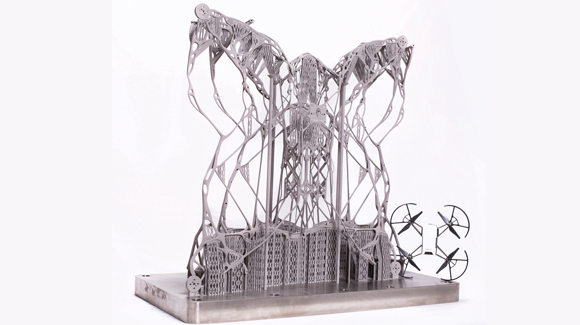Aeroswift metal Additive Manufacturing machine used to produce large UAV frame
April 29, 2019

Aeroswift’s Laser Powder Bed Fusion metal Additive Manufacturing machine (Courtesy Aeroswift)
The South African Aeroswift project, launched in 2011 by aviation manufacturing solutions company Aerosud Innovation Center, Pretoria, and the South African Council for Scientific and Industrial Research (CSIR), has successfully additively manufactured a metal frame for an Unmanned Aerial Vehicle (UAV). Aeroswift was launched with the aim of developing the world’s largest and fastest metal Additive Manufacturing system for the production of titanium aircraft parts, to improve market competitiveness and provide South Africa with a competitive edge in metal AM.
The project has since developed a Laser Powder Bed Fusion (L-PBF) system which it reports makes it possible to build parts at up to 2 m long, 600 mm wide and 600 mm high, at speeds up to ten times faster than other commercially available laser-based systems. To showcase the manufacturing scope and capabilities of the system and its build volume for very large aerospace components, Aeroswift recently collaborated with software provider Altair, Troy, Michigan, USA, to develop a methodology for designing large additively manufactured products.
The titanium UAV frame, measuring 542 x 542 x 141 mm, was designed as a demonstration part and subsequently built on the Aeroswift system. To improve manufacturability while meeting all component requirements, the project engineers used Altair’s Altair InspireTM simulation software and its topology optimisation capabilities during the design process.
In the first step, the project team specified the requirements of the UAV aircraft and frame. The design process included UAV flight requirement specifications, electronic component and drivetrain selection, mechanical design employing topology optimisation techniques, aesthetic improvements and manufacturability improvements. To truly demonstrate the capabilities of the Aeroswift system, the designers had to meet a substantial list of demanding manufacturing requirements.
In addition to frame design specifications, which had to accommodate the build volume of the AM system and the required symmetrical motor placement of the UAV, the team also had to include aesthetic aspects in the design process, as well as achieving flight times of a minimum 15 minutes at a thrust-to-weight ratio of at least 2.5:1, while the frame stiffness also had to be maximised.

The metal additively manufactured UAV frame produced by Aeroswift (Courtesy Aeroswift)
First, a basic concept design was created using primitive volumes with as little detail as possible, which was then imported into Altair Inspire to run a baseline finite element analysis. Subsequent optimisations and performance checks ensured that the generated topology facilitated all the required connections between the components of the assembly.
The engineers phased their topology optimisation approach by opting to run a first-step optimisation with increased branch sizes, to reduce the computational complexity in finding primary load paths. This process produced the thickness boundaries which encompassed the optimal design. The Aeroswift team could then recreate the resulting geometry and run a second-stage topology optimisation with thinner branches.
“We are very pleased with the results– using Altair Inspire, we could set up a process that helped us to achieve a topologically optimised UAV frame showing even better results than the benchmark,” stated Jacobus Prinsloo, Operations Manager at ADC Aeroswift. “Without Altair and their tools, we would not have been able to leverage the full potential of Additive Manufacturing in the aerospace industry.”
















